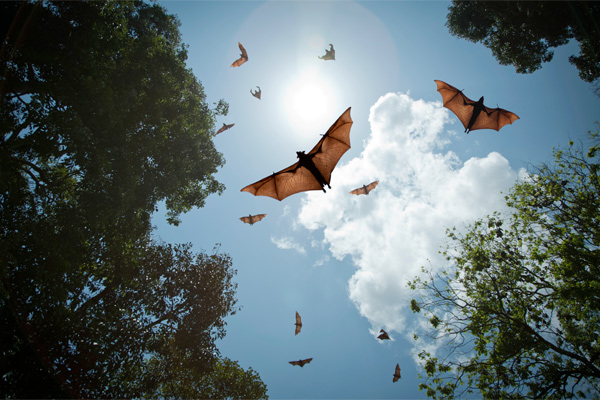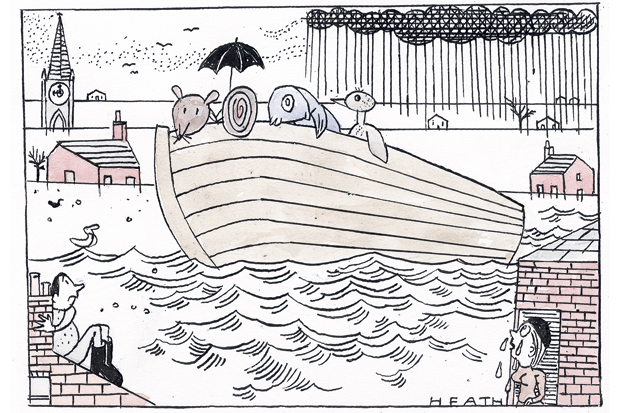Imagine: it’s Sunday morning, and the warden of a medieval village church arrives to get the place ready for communion only to find the altar covered in bat droppings.
As he gets scrubbing, he reflects on how he rang the officials at Natural England to request help getting rid of these bats — ‘Perhaps they could be relocated somewhere?’ he asked innocently — but their response was to read him the riot act about his responsibilities to the bats under EU law.
To fulfil its obligations, the church had to install a leaded ‘bat flap’ to let the creatures in and out — a dedicated window the bats can use to come and go as they please. And because the church is a Grade I listed building, it had to have one made up in the same material as the rest of the windows, at a cost of several hundred pounds.
Worse, the church has had to pay thousands to have an official bat survey done, to assess the extent and nature of their bat population. The vicar has been on the phone to the Bat Welfare Society helpline for more hours than he cares to remember to ensure he doesn’t incur a fine or prison sentence for disturbing the creatures. He now sets aside part of his week to liaise with the Church of England’s ‘bat working group’. The proceeds of the collection plate are pretty much entirely spent on bat management.
The bats, meanwhile, show no signs of gratitude and are urinating and defecating on the medieval wall paintings. The ammonia from their waste is eroding the precious brasses. The people who use the church — the congregation, playgroups, old people’s lunch clubs and evening classes — are not all that keen on having bats fly above their heads as they do pilates or sing ‘Jerusalem’, but what do they matter? While the bats are covered by the ironclad EU habitat directive, there is no equivalent law protecting heritage artefacts, community buildings, or indeed people.
In the battle of the species now raging in this sleepy little village, winged creatures trump humans. It is survival of the cutest, I’m afraid, and if I were a betting woman I would put my money on the bats.
This is not the script of a comedy vampire saga I’m working up, by the way. This is what is happening in churches all over the country, and to householders too, if they find bats in their roof space. All bats are protected species and Natural England, the government’s statutory wildlife adviser, needs to be consulted in advance of any work or action that might affect them. The law prevents you not only from getting rid of bats directly, but also forbids any stuffing up of the holes they are entering and exiting by (‘intentionally or recklessly obstructing access to a bat roost’) or attempts to shut them into a confined space where they won’t thrive.
There were 339 incidents of bat-related crime in 2011. That doesn’t sound a lot to me, but what do I know? According to the Bat Conservation Trust’s Bat Crime Annual Report, the rate is very worrying. As part of attempts to crack down, a man in Bolton was fined £700 earlier this month for disturbing bats in a house he was renovating. David Dalton, 33, had engaged the services of a surveyor who found a roost of brown long-eared bats. To allow the building to be developed legally, a European Protected Species Mitigation Licence costing thousands of pounds would have been required outlining how the ‘needs of the bats’ were being considered. Some householders have spent £10,000 or more trying to get one of these, which requires the complex analysis of a licensed bat consultant, charging by the hour, and ongoing bat monitoring that takes years, in some cases.
Mr Dalton demolished the building without a licence and destroyed the bat roost, naughty boy. Lancashire Police’s wildlife crime unit stepped in. The Bat Conservation Trust welcomed the prosecution, but said the fine was too lenient, which it was in the sense that it was only a fraction of what it costs to deal with bats legally.
But while developers are sometimes gung-ho enough to run the gauntlet of bat laws, churches scrupulously abide by the rules with the result that they are being crippled by the cost of playing host to batty. It is estimated that 6,400 parish churches in England are currently occupied by bats that have been granted indefinite leave to remain.
A recent Commons debate highlighted their plight. Tony Baldry, the MP who represents the Church Commissioners, says: ‘Bats are God’s creatures. If you are a bat and you are looking for somewhere to live, a church is a pretty attractive place. But churches are enduring invasions of bat colonies and it is becoming very difficult.’ One church in Yorkshire has spent £29,000 trying to deal with the problem. ‘The churches ring up Natural England for help and are told they have to manage the problem themselves. The authorities handle the issue from the perspective of the bat. It is Kafkaesque.’
Campaigners ‘against’ bats acknowledge that bats are under stress. They have a legitimate grievance. Their habitats have been destroyed by people converting barns into trendy houses. They deserve to be cared for, just not at the expense of human beings, although this over-protectiveness of a threatened species does seem to be part of a wider trend.
Putting aside the issue of foxes, which we must park or I will get seriously diverted, the wildlife lobby gives the impression of becoming increasingly strident. In particular, there appears to be a neurotic obsession with the three Bs, by which I mean bats, bees and badgers. It sometimes feels, for example, as if the wildlife brigade would prefer that all cattle perished of TB rather than farmers harm one hair on the head of a badger, and that fields full of crops can shrivel and die so long as insecticide isn’t used that might kill bees.
All of this is rather detrimental to food production, of course, but the wildlife groupies don’t seem to worry too much about that. They don’t bat an eyelid, pardon the pun, if their determination to protect a species of animal is compromising the ability to thrive of the human species.
Sir Baldry, who will continue the campaign at Westminster in the autumn, says: ‘I blame Beatrix Potter, frankly. It is the anthropomorphisation of Peter Rabbit.’
And Bertie Bat, as he likes to be known.
Got something to add? Join the discussion and comment below.
Get 10 issues for just $10
Subscribe to The Spectator Australia today for the next 10 magazine issues, plus full online access, for just $10.
You might disagree with half of it, but you’ll enjoy reading all of it. Try your first month for free, then just $2 a week for the remainder of your first year.















Comments
Don't miss out
Join the conversation with other Spectator Australia readers. Subscribe to leave a comment.
SUBSCRIBEAlready a subscriber? Log in